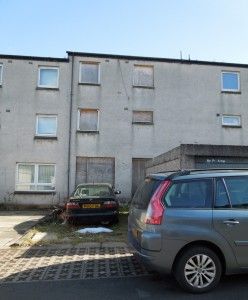The physical, social and economic regeneration challenges caused by high levels of long-term vacant private sector housing in Scotland’s towns and cities have long been recognised by SURF, Shelter Scotland, the SFHA, local and national government, and other players. In this article, Kristen Hubert highlights the progress that the Scottish Empty Homes Partnership has made in recent years, and the policy tools that need to be brought in to further alleviate the problem.
There are over 27,000 long-term private sector empty homes in Scotland that have been lying vacant for six months or more. At the same time, housing waiting lists are more than five times this figure.
Empty homes work can’t solve the housing crisis, but it surely needs to be part of the housing supply solution. Housing supply is, however, only one driver for empty homes work.
Bringing empty homes back into use can also contribute to regeneration efforts; help to sustain rural towns and villages; increase feelings of community safety and satisfaction; and bring valuable spend into a community through renovation work and new local residents.
People Power
The Scottish Empty Homes Partnership was established in 2010 with funding from Scottish Government and found a home for itself at Shelter Scotland. Since this time, we’ve expanded both the size of our team and the scope of our work, but our focus has remained the same.

There are more than 27,000 empty homes in Scotland
We’ve worked hard to sell the benefits of empty homes work. In terms of renovation costs, on average it costs between £6k-£25k to bring an empty home back into use, compared to £100k+ for a new build property. That renovation cost is borne by the owner. Some empty homes don’t need renovation at all to be brought back into use. We’ve also pushed for funding streams and council tax powers to make it easier for local Empty Homes Officers to be as effective as possible.
From our experience, people power has brought most empty homes back into use. Many owners just need a bit of hand-holding and someone to challenge their assumptions. Currently, just over half of Scotland’s Local Authorities have at least one member of staff dedicated to Empty Homes work. When we opened up shop there were none.
 It is as we have seen the recruitment and skilling up of Empty Homes Officers providing targeted advice to owners that we’ve started to see homes coming back into use. It’s our job to make their jobs easier by providing training, tools and advice. Of course, these officers don’t work in a vacuum, and they rely on council colleagues and external partners to help them problem solve solutions that work.
It is as we have seen the recruitment and skilling up of Empty Homes Officers providing targeted advice to owners that we’ve started to see homes coming back into use. It’s our job to make their jobs easier by providing training, tools and advice. Of course, these officers don’t work in a vacuum, and they rely on council colleagues and external partners to help them problem solve solutions that work.
Last year, councils reported to us that they brought 560 empty homes back into use and we’ve calculated the combined value of these properties as £93m. That is a huge influx into the supply chain that had been lying dormant.
Practical Policy Tools

An empty home in Dumbarton before and after refurbishment
What we would like to see is all councils with at least one dedicated Empty Homes Officer – and ideally on permanent contracts. We know that Empty Homes Officers bring in more than the cost of their salary in terms of debt collection, increased council tax (empty homes often receive council tax discounts and exemptions in their first year empty), and community benefits that are much harder to quantify including improved safety and security, increased spend in the community from more residents and jobs for local contractors.
We really do believe that working with owners pro-actively and positively is the best way to bring empty homes back into use. We also believe councils and communities should have effective enforcement powers as a last resort where empty homes are having negative impacts on local communities.
We can see two options for this. Our gold standard option is a Housing Reuse Power that would allow councils to either put up for sale or lease out problem empty properties. This proposed power was endorsed by the Land Reform Review Group.
As a second option, we also support the recommendation of the Land Reform Review Group that a Compulsory Sale Order be introduced to force the sale of empty land and property that has been unused for three years. While this second option doesn’t allow for a leasing option, it does do most of what we think is necessary, which is to give councils a tool they would plausibly use that will effect a change.
Oftentimes a change of ownership is all that is needed as usually the issue keeping the property empty is not to do with the location or fabric of the property itself but with the mind-set, skills or financial situation of the owner. Current powers, such as Compulsory Purchase, are just too costly and time consuming for most councils to consider. We need something they will actually use.

Beyond Housing Supply
We also want to see a larger variety of funding streams for different types of players to get into the game of bringing empty homes back into use. Currently funding streams like the Scottish Empty Homes Loan Fund or the Town Centre Empty Homes Fund are focused on a small sub-section of empty homes and empty home owners. We want to see a variety of financial incentives, for instance there is nothing currently out there to encourage the purchase and restoration of an empty home by a first time buyer.

A long-term empty home in Falkirk (l) brought back into use (r)
We think successful funding streams from England, like the Empty Homes Community Grant Programme, should be considered for Scotland. There is also a gap when it comes to the worst empty homes that have fallen into serious disrepair that need more than a small loan or grant to make them economically viable to bring back into use.
This is where we need to see the issue of empty homes as something wider than just a housing supply issue. Empty homes have impacts on community wellbeing that go far beyond the standard mathematics of housing supply and this needs to be taken into account when it comes to funding.
The Scottish Empty Homes Conference this November is where we’ll be fleshing a lot of this out with interested professionals from a range of backgrounds. This year the theme of our conference is Local Effort, Local Impact and the keynote speaker, George Clarke, UK Empty Homes Adviser and TV Architect, will be sharing some of his lessons learned from visiting communities with empty homes problems form across the country. We would welcome input and ideas from a range of sectors on the day.
For further information, visit the Scottish Empty Homes Partnership’s website, or contact the Scottish Empty Homes Advice Service on 0344 515 1941 or emptyhomes@shelter.org.uk.
